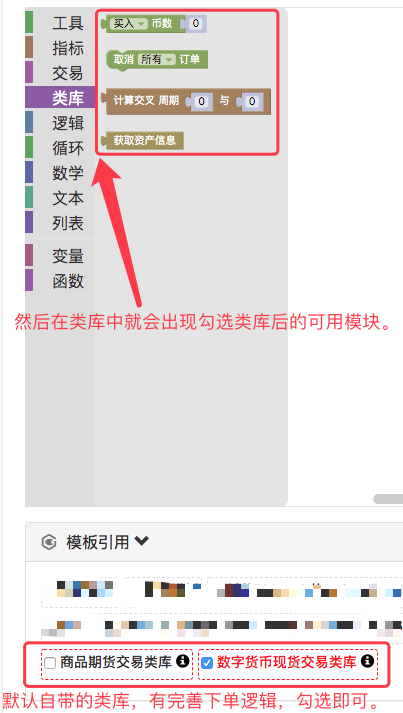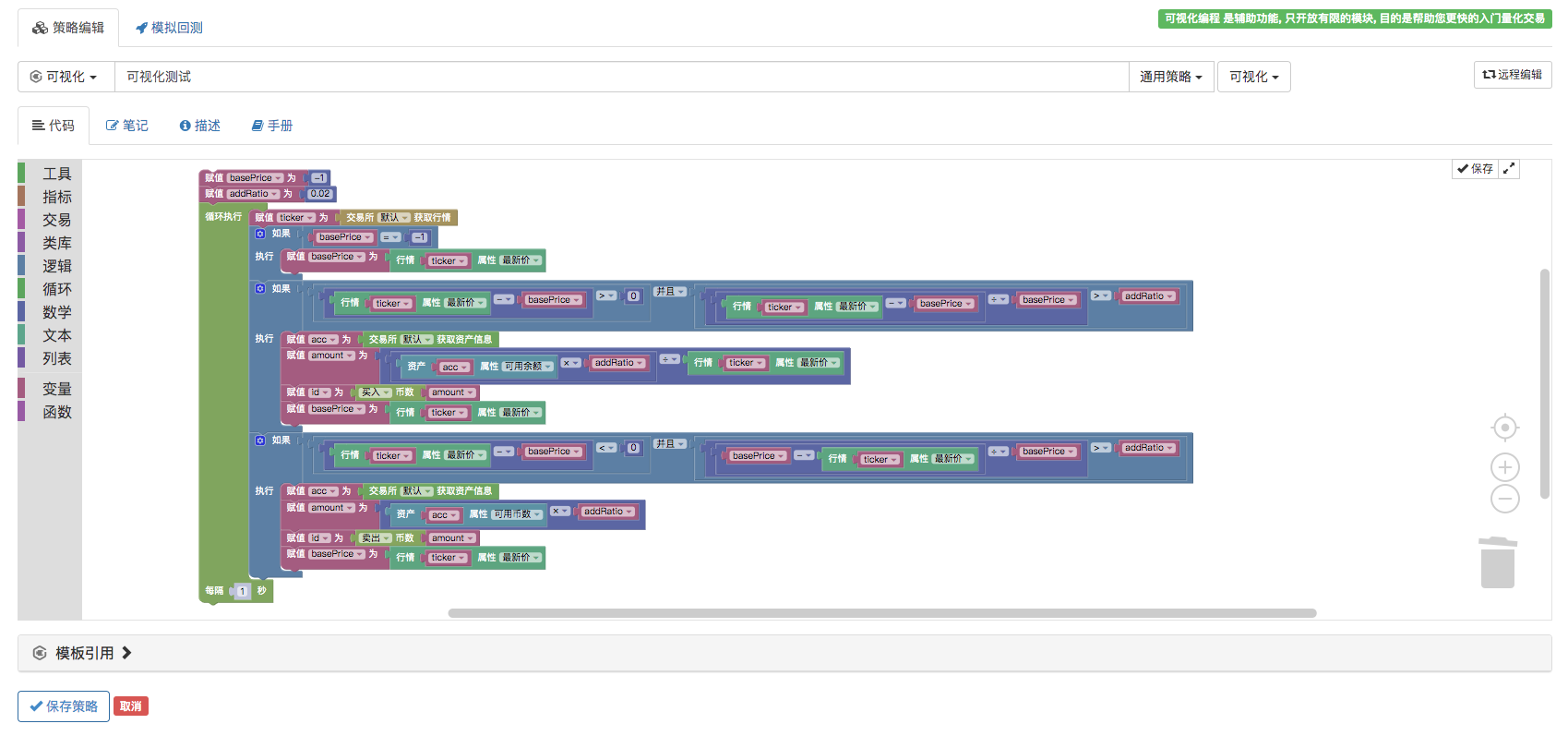Visualizing modules to build trading strategies - out
Author: Inventors quantify - small dreams, Created: 2019-07-29 09:04:35, Updated: 2023-10-20 20:09:03
Visualization modules to build trading strategies
By studying the content of the previous chapters of this series, you will have a basic understanding of the use of various types of visualization modules. In this chapter, we use a simple but interesting strategy to build a visualization module.
-
A simple, violent but fun chase-and-fall strategy
-
Strategic thought
The core of the strategy is to chase down, choose the market for the digital currency spot market, such as BTC_USDT, according to the price at the time of the strategy's operation, the price rises by a certain percentage, then buy a certain percentage of the current asset, and sell a certain percentage of the current asset.
-
Select Visualize class libraries and add multiple modules
Before we started building, we added some reusable modules.

As shown above:
The class libraries contain reusable packages that can be used after selection. The selected "digital currency spot market library" is a trading library for the digital currency spot market, which internally handles complex detection, retesting, etc. logics (e.g. how to handle transactions without a transaction after placing an order, etc.). This is a very convenient way to build strategies without a lot of complicated processing logic.
-
Spelling of policy modules

Since the strategic idea is simple, the strategic modules are put together, not very big. We are reassured that in less than a year from October 18th, there will be a large number of shocks and trends, which can be used as a preliminary testing strategy. The parameters of the retest:

Here's how this strategy performed in retesting:

An equivalent JavaScript language strategy, also released at the same time, can be studied by interested students. By learning how to build strategies through visualization modules, it is easy to get started with the conception of strategies, the use of various interfaces and programmatic transactions.
The strategy has no other interface parameters, and interested students can optimize the extension.
function main() { var basePrice = -1 var addRatio = 0.02 while (true) { var ticker = exchange.GetTicker() if (basePrice == -1) { basePrice = ticker.Last } if ((ticker.Last - basePrice) > 0 && ((ticker.Last - basePrice) / basePrice > addRatio)) { var acc = exchange.GetAccount() var amount = acc.Balance * addRatio / ticker.Last $.Buy(amount) basePrice = ticker.Last } if ((ticker.Last - basePrice) < 0 && ((basePrice - ticker.Last) / basePrice > addRatio)) { var acc = exchange.GetAccount() var amount = acc.Stocks * addRatio $.Sell(amount) basePrice = ticker.Last } } }A very interesting part of this strategy is that when the account asset is initially set to a coin and a cash value equivalent, for example, BTC_USDT trading pair, where the current price of BTC is 10,000, the account coin is divided into five, then the USDT is divided into 50,000.
The strategy is to take a neutral approach to market conditions, where prices are falling. I'm going to try to allocate a little bit less USDT, a little bit more currency. For example:

There is a marked change in the measurement.
You can also set up more USDT and less currency.

In the meantime, let's put together modules and try out our own programmatic trading ideas.
-
Visualizing the paradigm strategy:
- https://www.fmz.com/strategy/121404
- https://www.fmz.com/strategy/129895
- https://www.fmz.com/strategy/123904
- https://www.fmz.com/strategy/122318
More tips can be found at:https://www.fmz.com/square
Other articles in this series
- Visualizing modules to build trading strategies - progress
- Visualizing modules to build trading strategies - a basic understanding
- Visualizing modules to build trading strategies - in depth
It's boring programming, it's easy to do with blocks, try it out, it's fun!
- Introduction to Lead-Lag Arbitrage in Cryptocurrency (2)
- Introduction to the Lead-Lag suite in the digital currency (2)
- Discussion on External Signal Reception of FMZ Platform: A Complete Solution for Receiving Signals with Built-in Http Service in Strategy
- Discussing FMZ platform external signal reception: a complete set of strategies for the reception of signals from built-in HTTP services
- Introduction to Lead-Lag Arbitrage in Cryptocurrency (1)
- Introduction to the Lead-Lag suite in digital currency (1)
- Discussion on External Signal Reception of FMZ Platform: Extended API VS Strategy Built-in HTTP Service
- External signal reception on FMZ platforms: extended API vs. built-in HTTP services
- Discussion on Strategy Testing Method Based on Random Ticker Generator
- Strategy testing methods based on random market generators explored
- New Feature of FMZ Quant: Use _Serve Function to Create HTTP Services Easily
- Quantitative trading strategies for price dynamics analysis with Python
- Timeline data analysis with Tick data retrieval
- The experience of developing trading strategies
- Calculation and application of DMI indicators
- Detailed usage and practical skills of energy tide(OBV) indicator in quantitative trading
- The development of CTA strategies and the inventor quantification platform standard library
- The use of a combination strategy for the strength and weakness of the RSI versus the straight line
- Upgrade Edition of Keltner Channel trading Strategy
- Neural network and digital currency quantitative trading series ((2)) Deep reinforcement learning training Bitcoin trading strategies
- Implementation and application of the inventor quantified platform in the fall line trading strategy
- KENTNA channel upgraded version of the KENTNA kingkeltner strategy
- Quantitative trading strategies with a trade index weighting
- Introducing the Aroon indicator
- The relative strengths and weaknesses of price-based quantitative trading strategies
- Introducing the adaptive moving average KAMA
- Implementation of Dual Thrust trading algorithms using My language on the inventor's quantification platform
- Introduction to RangeBreak Strategy
- Trading strategy based on box theory
- Trading strategies based on box theory that support commodity futures and digital currencies
- Thermometer strategies in the practice and application of inventor quantization platforms